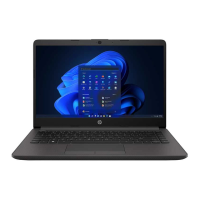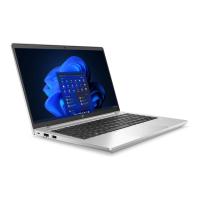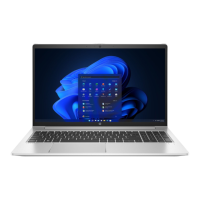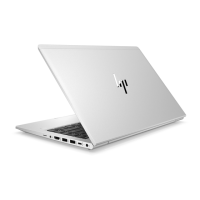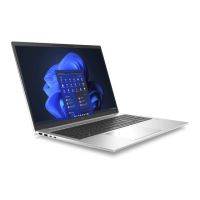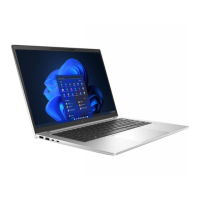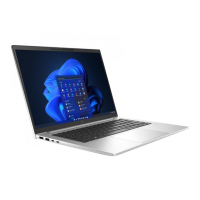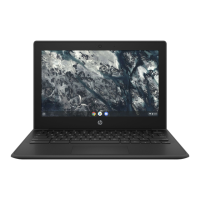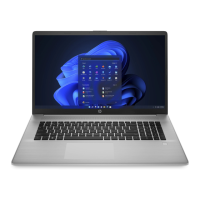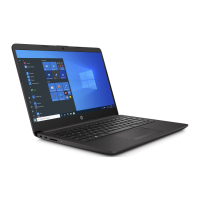Do you have a question about the HP 240R G9 and is the answer not in the manual?
Lists and describes major components like processor, display, memory, storage, audio, and ports.
Details audio, wireless networking, and ports like RJ-45 and USB.
Lists security features like fingerprint reader and supported operating systems.
Identifies and describes external components on the right, left, and bottom sides, plus labels.
Details display components, keyboard area, touchpad, indicator lights, buttons, and special keys.
Illustrates and lists major computer components with their spare part numbers.
Illustrates display subcomponents and lists miscellaneous parts with spare part numbers.
Lists tools, general service advice, and handling precautions for parts, cables, and drives.
Covers ESD information, prevention methods, grounding techniques, and recommended materials.
Provides steps for cleaning, disinfecting, caring for wood veneer, and packaging the computer.
Explains how to find HP support information, technical bulletins, and repair professionals.
Covers preparation for disassembly and removal of rubber feet and the bottom cover.
Details procedures for replacing the battery, WLAN module, memory module, and solid-state drive.
Guides on replacing speakers, touchpad, USB/power button board, and the fan.
Explains how to replace the system board, heat sink, and the complete display assembly.
Details replacement of display hinges, bezel, camera module, and display panel.
Covers the removal and replacement of the power connector and the top cover with keyboard.
Details using the Windows diagnostic tool, handling failure IDs, and download methods.
Explains using the UEFI diagnostic tool, handling failure IDs, and download procedures.
Covers BIOS steps for memory management, security resets, and answers common questions.
Provides a table detailing nonvolatile memory types and troubleshooting steps.
Outlines universal and country-specific requirements for power cord sets, including agency approvals.
Lists and describes major components like processor, display, memory, storage, audio, and ports.
Details audio, wireless networking, and ports like RJ-45 and USB.
Lists security features like fingerprint reader and supported operating systems.
Identifies and describes external components on the right, left, and bottom sides, plus labels.
Details display components, keyboard area, touchpad, indicator lights, buttons, and special keys.
Illustrates and lists major computer components with their spare part numbers.
Illustrates display subcomponents and lists miscellaneous parts with spare part numbers.
Lists tools, general service advice, and handling precautions for parts, cables, and drives.
Covers ESD information, prevention methods, grounding techniques, and recommended materials.
Provides steps for cleaning, disinfecting, caring for wood veneer, and packaging the computer.
Explains how to find HP support information, technical bulletins, and repair professionals.
Covers preparation for disassembly and removal of rubber feet and the bottom cover.
Details procedures for replacing the battery, WLAN module, memory module, and solid-state drive.
Guides on replacing speakers, touchpad, USB/power button board, and the fan.
Explains how to replace the system board, heat sink, and the complete display assembly.
Details replacement of display hinges, bezel, camera module, and display panel.
Covers the removal and replacement of the power connector and the top cover with keyboard.
Details using the Windows diagnostic tool, handling failure IDs, and download methods.
Explains using the UEFI diagnostic tool, handling failure IDs, and download procedures.
Covers BIOS steps for memory management, security resets, and answers common questions.
Provides a table detailing nonvolatile memory types and troubleshooting steps.
Outlines universal and country-specific requirements for power cord sets, including agency approvals.
| Graphics | Intel Iris Xe Graphics |
|---|---|
| Bluetooth | Bluetooth 5.2 |
| Processor | Intel Core i7-1255U |
| RAM | Up to 32 GB DDR4 |
| Storage | 512 GB SSD |
| Display | 14-inch FHD (1920 x 1080) |
| Operating System | Windows 11 Pro |
| Ports | HDMI, headphone/microphone combo |
| Wireless | Wi-Fi 6 |
| Battery | 3-cell 41Wh Li-ion |
| Weight | Starting at 1.47 kg |
| Dimensions | 32.4 x 1.99 cm |
